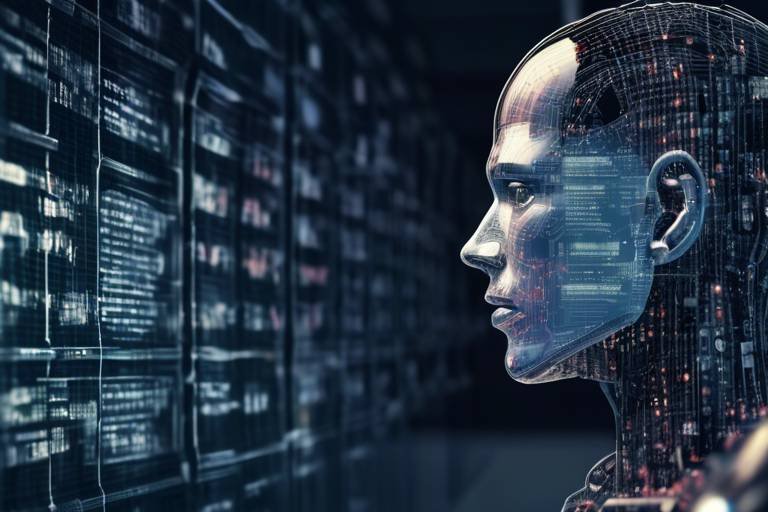Will AI be the Future of Predictive Analysis?
The world is evolving at a breakneck speed, and with it, the way we analyze data is undergoing a significant transformation. Have you ever wondered how businesses can predict trends before they happen? Or how they can make decisions based on data rather than gut feelings? Enter artificial intelligence (AI), a game-changer in the realm of predictive analysis. This article dives deep into how AI is reshaping this field, making it not only more accurate but also more accessible to various industries.
Predictive analysis has been around for decades, but the introduction of AI technologies has taken it to a whole new level. Imagine having a crystal ball that not only shows you the future but also learns from past data to improve its predictions. Sounds magical, right? But it’s not magic; it’s the power of AI at work! By leveraging vast datasets, AI can identify patterns and trends that traditional methods might miss, leading to more informed decision-making.
But why should we care about predictive analysis? Well, it’s not just for big corporations looking to maximize profits. Predictive analysis can be a lifesaver in various sectors, from healthcare, where it can predict patient outcomes, to finance, where it can forecast market trends. The potential applications are virtually limitless, and as AI continues to evolve, so will the possibilities.
However, the journey of integrating AI into predictive analysis isn’t without its bumps. There are challenges to consider, such as data privacy concerns and algorithmic bias, which can skew results and lead to unfair outcomes. But with the right strategies and technologies, these hurdles can be overcome, paving the way for a future where AI-driven predictive analysis is the norm rather than the exception.
As we look ahead, it’s clear that the fusion of AI and predictive analysis is just beginning. With advancements in machine learning, neural networks, and data processing capabilities, the tools available to analysts are becoming increasingly sophisticated. So, the real question is not whether AI will be the future of predictive analysis, but rather how quickly we can harness its full potential. Are you ready to embrace this exciting future?
- What is predictive analysis? Predictive analysis involves using historical data and statistical algorithms to identify the likelihood of future outcomes.
- How does AI improve predictive analysis? AI enhances predictive analysis by analyzing large datasets quickly, identifying patterns, and making predictions with greater accuracy than traditional methods.
- What industries can benefit from AI-driven predictive analysis? Several industries, including healthcare, finance, retail, and manufacturing, can leverage AI for better decision-making and forecasting.
- What are the challenges of implementing AI in predictive analysis? Challenges include data privacy concerns, algorithmic bias, and the need for transparency in AI models.
- Is AI the only technology used for predictive analysis? No, while AI plays a significant role, other techniques like statistical analysis and data mining are also important.

The Evolution of Predictive Analysis
Predictive analysis has come a long way since its inception, evolving from basic statistical methods to the sophisticated AI-driven techniques we see today. In its early days, predictive analysis relied heavily on historical data and simple algorithms, which often resulted in limited accuracy and scope. As technology advanced, so did the methodologies used for prediction. The integration of computers into data analysis allowed for more complex calculations and the handling of larger datasets, paving the way for more reliable forecasts.
In the 20th century, the field began to take shape with the introduction of statistical models. Techniques such as regression analysis and time series forecasting became the cornerstone of predictive analysis, enabling analysts to make educated guesses based on past trends. However, these traditional methods had their drawbacks; they often required extensive manual input and were prone to human error. As a result, the predictions made were sometimes more art than science, relying on intuition as much as on data.
Fast forward to the dawn of the 21st century, and we see a significant shift as machine learning and artificial intelligence entered the scene. With the ability to process vast amounts of data quickly and efficiently, AI technologies began to transform predictive analysis into a more dynamic and accurate discipline. The emergence of big data has also played a crucial role, providing a wealth of information that can be analyzed to uncover hidden patterns and trends.
Today, predictive analysis is used across various industries, from finance and healthcare to marketing and supply chain management. Companies now leverage advanced algorithms to not only forecast future trends but also to make real-time decisions that can significantly impact their operations. For instance, in retail, predictive analysis helps businesses anticipate customer needs and optimize inventory levels, ensuring they have the right products at the right time.
Moreover, the evolution of predictive analysis has led to the development of more sophisticated tools and platforms that allow businesses to harness the power of AI without needing extensive technical expertise. These tools often come equipped with user-friendly interfaces that make it easier for decision-makers to interpret data and gain insights. As we look to the future, the continued integration of AI into predictive analysis promises even greater advancements, making it an indispensable asset for organizations aiming to stay ahead of the competition.
In summary, the evolution of predictive analysis reflects a journey from simple statistical methods to complex AI-driven models. This transformation has not only enhanced the accuracy of predictions but has also democratized access to powerful analytical tools, enabling businesses of all sizes to make data-driven decisions.

How AI Enhances Predictive Models
Artificial Intelligence (AI) is not just a buzzword; it’s a powerful tool that has revolutionized how we approach predictive analysis. Imagine trying to predict the weather without the aid of satellites and advanced algorithms. It would be like trying to navigate a ship through fog without a compass. AI enhances predictive models by providing the necessary clarity and precision that traditional methods often lack. By harnessing the capabilities of machine learning and deep learning, AI analyzes vast amounts of data, uncovering patterns that humans might miss, leading to forecasts that are not only more accurate but also more reliable.
One of the standout features of AI in predictive analysis is its ability to learn and adapt over time. This is where machine learning techniques come into play. For instance, regression analysis helps in understanding relationships between variables, while classification techniques categorize data into distinct groups. These methods enable predictive models to refine their predictions as they are exposed to new data. Think of it as a student who learns from past mistakes to ace future exams. The more data the model processes, the smarter it becomes.
Machine learning techniques can be broadly categorized into two types: supervised learning and unsupervised learning. The former involves training a model on a labeled dataset, where the outcomes are known. This allows the model to learn the relationship between input and output, akin to teaching a child with flashcards. On the other hand, unsupervised learning deals with datasets that do not have labeled outcomes. It’s like giving a child a box of assorted toys and letting them figure out how to categorize them. Both approaches serve unique purposes in predictive analysis, enhancing the model’s ability to provide insights.
Now, let’s talk about neural networks, which are at the forefront of AI-driven predictive models. These networks are designed to mimic the way human brains operate, processing information through interconnected nodes. This structure allows them to recognize complex patterns in data—think of it as a sophisticated web of neurons firing in response to stimuli. The ability of neural networks to analyze non-linear relationships makes them particularly effective in fields such as finance, healthcare, and marketing, where predictions often hinge on multifaceted data.
However, it’s essential to remember that the effectiveness of AI-enhanced predictive models hinges on the quality of data used. High-quality data acts as the foundation upon which these models are built. If the data is flawed, the predictions will be too. Therefore, ensuring data integrity and relevance is paramount. It’s akin to cooking; if you start with rotten ingredients, no amount of seasoning will save the dish.
In summary, AI significantly enhances predictive models by utilizing advanced techniques like machine learning and neural networks, enabling organizations to make data-driven decisions with confidence. As we continue to explore the vast potential of AI in predictive analysis, the possibilities seem endless, paving the way for smarter, more efficient decision-making processes across various industries.
- What is predictive analysis? Predictive analysis involves using statistical algorithms and machine learning techniques to identify the likelihood of future outcomes based on historical data.
- How does AI improve predictive analysis? AI improves predictive analysis by analyzing large datasets, identifying patterns, and making predictions that are more accurate than traditional methods.
- What are the challenges of using AI in predictive analysis? Some challenges include data privacy concerns, algorithmic bias, and the need for transparency in AI models.
- What industries benefit from AI predictive analysis? Industries such as finance, healthcare, marketing, and retail benefit significantly from AI predictive analysis.

Machine Learning Techniques
When it comes to predictive analysis, machine learning techniques are the backbone of modern advancements. These techniques allow systems to learn from data, adapt over time, and ultimately make predictions that are not only accurate but also insightful. Imagine having a personal assistant who learns your preferences and habits, making decisions tailored just for you—that's the power of machine learning in predictive analysis.
One of the most common methods used in machine learning is regression analysis. This technique helps in understanding the relationship between variables. For instance, if a company wants to predict its sales based on advertising spend, regression analysis can provide a clear picture of how much increase in sales can be expected with each dollar spent on ads. It's like having a crystal ball that can forecast financial outcomes based on historical data.
Another pivotal technique is classification. This method categorizes data into predefined classes. For example, an email filtering system uses classification to determine whether an email is spam or not. By analyzing various features of the email, such as the sender's address or specific keywords, the system can classify it accordingly. It’s akin to sorting your laundry into whites and colors—each piece of clothing goes into its respective pile based on established criteria.
To further illustrate how these techniques work, let’s take a look at a simple comparison:
| Technique | Purpose | Example |
|---|---|---|
| Regression Analysis | Predicts a continuous outcome | Sales prediction based on advertising spend |
| Classification | Categorizes data into classes | Email spam detection |
Moreover, the distinction between supervised and unsupervised learning is crucial in predictive analysis. Supervised learning uses labeled data to train models, allowing them to learn from examples. In contrast, unsupervised learning works with unlabeled data, discovering hidden patterns without explicit instructions. This is like teaching a child to identify animals; with supervised learning, you show them pictures of cats and dogs, while unsupervised learning would involve them exploring a zoo without prior knowledge of the animals.
Finally, we cannot overlook the role of neural networks in enhancing predictive analysis. These sophisticated algorithms mimic the workings of the human brain, enabling complex pattern recognition. Neural networks excel at analyzing large datasets and can uncover intricate relationships that traditional methods might miss. For instance, in the healthcare industry, neural networks can analyze patient data to predict disease outbreaks or treatment outcomes, ultimately saving lives. It's like having a team of detectives who can piece together clues faster than any human could.
In summary, machine learning techniques are essential for refining predictive analysis. They not only enhance the accuracy of predictions but also empower organizations to make data-driven decisions that can lead to significant advancements across various industries.
- What is machine learning? Machine learning is a subset of artificial intelligence that enables systems to learn from data and improve their predictions over time without being explicitly programmed.
- How does regression analysis work? Regression analysis examines the relationship between variables to predict a continuous outcome based on historical data.
- What is the difference between supervised and unsupervised learning? Supervised learning uses labeled data to train models, while unsupervised learning analyzes unlabeled data to find hidden patterns.
- What role do neural networks play in predictive analysis? Neural networks simulate human brain functions to identify complex patterns in large datasets, improving the accuracy of predictions.

Supervised vs. Unsupervised Learning
When diving into the world of artificial intelligence, particularly in predictive analysis, one of the most critical distinctions to understand is between supervised and unsupervised learning. These two approaches serve different purposes and are essential for building effective predictive models. Imagine you're a teacher guiding students (supervised learning) versus letting them explore and learn on their own (unsupervised learning). Sounds simple, right? But the implications are profound.
In supervised learning, we train our models using labeled datasets. This means that each training example is paired with an output label, which acts like a guiding hand. For example, if we're trying to predict whether an email is spam or not, we would provide the model with numerous emails that are already categorized as either "spam" or "not spam." The model learns from these examples and can then make predictions on new, unseen emails. This method is particularly effective when we have a clear outcome we want to predict.
On the other hand, unsupervised learning works without labeled outputs. Here, the model tries to learn the underlying patterns and structures from the data itself. Think of it as a detective sifting through clues without knowing what crime has been committed. For instance, if we have a dataset of customer purchases without any labels, unsupervised learning techniques can help identify clusters of similar purchasing behaviors. This can be incredibly valuable for market segmentation and personalized marketing strategies.
To illustrate the differences further, let’s take a look at the key characteristics of both approaches:
| Feature | Supervised Learning | Unsupervised Learning |
|---|---|---|
| Data Type | Labeled Data | Unlabeled Data |
| Goal | Predict outcomes based on input | Discover patterns and structures |
| Common Algorithms | Linear Regression, Decision Trees | K-Means Clustering, Hierarchical Clustering |
| Use Cases | Spam detection, Credit scoring | Customer segmentation, Anomaly detection |
Both supervised and unsupervised learning have their unique advantages and challenges. The choice between the two often depends on the specific problem at hand and the type of data available. Supervised learning can yield more accurate predictions when labeled data is abundant, while unsupervised learning shines in situations where uncovering hidden patterns is paramount.
As we continue to explore the exciting realm of AI and predictive analysis, understanding these fundamental differences will empower us to leverage the right techniques for our specific needs. This knowledge not only enhances our predictive capabilities but also opens up new avenues for innovation across various industries.
- What is supervised learning? Supervised learning is a type of machine learning where models are trained using labeled data, allowing them to predict outcomes based on input data.
- What is unsupervised learning? Unsupervised learning involves training models on unlabeled data, enabling them to identify patterns and groupings without prior knowledge of outcomes.
- When should I use supervised learning? Use supervised learning when you have a clear outcome to predict and sufficient labeled data available.
- When is unsupervised learning more appropriate? Unsupervised learning is ideal when you want to explore data without predefined labels and discover hidden patterns.

Neural Networks in Prediction
Neural networks have truly transformed the landscape of predictive analysis, bringing a level of sophistication that was once thought to be the realm of science fiction. Imagine a system that can learn from vast amounts of data, much like how our brains process information. This capability allows neural networks to recognize complex patterns and relationships within data that traditional methods might miss. By mimicking the interconnected neurons in our brains, these networks can adjust and optimize their predictions based on new information, making them incredibly powerful for a variety of applications.
One of the standout features of neural networks is their ability to handle unstructured data, such as images, audio, and text. This flexibility opens up a world of possibilities for predictive analysis across different industries. For instance, in healthcare, neural networks can analyze medical images to predict diseases, while in finance, they can analyze transaction data to identify potential fraud. The adaptability of neural networks means that they can be trained for specific tasks, continually improving their accuracy over time.
Moreover, the architecture of neural networks can vary significantly depending on the complexity of the task. For example, convolutional neural networks (CNNs) are particularly effective for image recognition tasks, while recurrent neural networks (RNNs) excel in processing sequential data, such as time series or natural language. This versatility allows businesses to tailor their predictive models to suit their unique needs, leading to more precise outcomes.
However, the power of neural networks comes with its own set of challenges. Training these networks requires substantial computational resources and high-quality data. Without clean and relevant data, the predictions generated can be misleading or inaccurate. Additionally, understanding the decision-making process of neural networks can be difficult, often referred to as the "black box" problem. This lack of transparency can be a concern, especially in industries where accountability is paramount.
In summary, neural networks represent a significant leap forward in predictive analysis. Their ability to learn from complex datasets and improve over time positions them as a cornerstone of modern AI applications. As we continue to refine these technologies and address their challenges, the potential for neural networks to revolutionize how we predict outcomes across various sectors is immense.
- What are neural networks? Neural networks are computational models inspired by the human brain, designed to recognize patterns and make predictions based on input data.
- How do neural networks improve predictive analysis? They enhance predictive analysis by learning from vast datasets, identifying complex patterns, and adapting their predictions over time.
- What industries benefit from neural networks? Industries such as healthcare, finance, marketing, and technology utilize neural networks for tasks like disease prediction, fraud detection, and customer behavior analysis.
- What challenges do neural networks face? Key challenges include the need for large amounts of high-quality data, computational resource requirements, and the difficulty in interpreting their decision-making processes.

Data Quality and Its Importance
When it comes to predictive analysis, the saying "garbage in, garbage out" couldn't be more accurate. The quality of data used in AI-driven models is not just a minor detail; it's the backbone of accurate predictions. Imagine trying to predict the weather using outdated or incorrect information—sounds ridiculous, right? Well, the same principle applies to predictive analysis in various industries. If the data is flawed, the predictions will be, too.
High-quality data is characterized by its accuracy, completeness, consistency, and relevance. Each of these attributes plays a crucial role in ensuring that the predictive models can function effectively. For instance, if the data is incomplete, the model may miss out on critical patterns, leading to skewed or entirely inaccurate forecasts. To put it simply, the integrity of the data is directly proportional to the reliability of the predictions made by AI.
Moreover, poor data quality can lead to significant financial losses and damage to a company’s reputation. According to a study by IBM, poor data quality costs the U.S. economy around $3.1 trillion annually. This staggering figure emphasizes the need for organizations to invest in high-quality data collection and management practices. Companies should implement robust data governance frameworks that ensure data is regularly validated and cleaned, thus maintaining its integrity.
In the realm of predictive analysis, organizations often utilize various data sources, including:
- Structured Data: This is highly organized data, such as databases and spreadsheets, which is easy to analyze.
- Unstructured Data: This includes text, images, and videos, which require more complex processing techniques to extract meaningful insights.
- Real-time Data: This data is collected and processed instantly, allowing for immediate analysis and decision-making.
Each type of data has its own set of challenges and opportunities. For example, while structured data is easier to manage, unstructured data can provide deeper insights when analyzed correctly. Therefore, organizations must adopt a holistic approach to data quality, ensuring that they leverage the strengths of various data types while minimizing their weaknesses.
In conclusion, the importance of data quality in predictive analysis cannot be overstated. As AI continues to evolve and integrate into various sectors, the demand for high-quality data will only increase. Organizations that prioritize data integrity will not only enhance their predictive capabilities but also gain a competitive edge in their respective markets.
- What is data quality? Data quality refers to the condition of a dataset, which includes its accuracy, completeness, consistency, and relevance.
- Why is data quality important in predictive analysis? High-quality data ensures that predictive models generate accurate and reliable forecasts, which are crucial for informed decision-making.
- How can organizations improve data quality? Organizations can improve data quality by implementing robust data governance practices, regular data validation, and utilizing advanced data management tools.
- What are the consequences of poor data quality? Poor data quality can lead to inaccurate predictions, financial losses, and damage to a company's reputation.

Challenges in AI-Driven Predictive Analysis
The integration of artificial intelligence into predictive analysis is undoubtedly a game-changer, but it doesn't come without its fair share of challenges. As we dive deeper into this fascinating intersection, it's crucial to understand the hurdles that can hinder the effectiveness of AI-driven predictive models. One of the most significant challenges is data privacy concerns. With the increasing amount of sensitive information being processed, ensuring that personal data remains protected is paramount. Companies must navigate a complex landscape of regulations, such as GDPR, to avoid hefty fines and maintain customer trust.
Another pressing issue is algorithmic bias. AI systems learn from historical data, and if that data reflects existing prejudices or inequalities, the predictions made by these systems can perpetuate or even exacerbate these biases. For instance, if a predictive model is trained on data that underrepresents certain groups, it may lead to skewed outcomes that unfairly disadvantage those populations. Developers need to be vigilant and implement strategies that promote fairness in AI models, ensuring that all demographic groups are accurately represented in the training data.
Moreover, the need for transparency in AI algorithms cannot be overstated. As these systems become more complex, understanding how decisions are made becomes increasingly difficult. Stakeholders, including end-users and regulatory bodies, demand clarity regarding how predictions are generated. This transparency is essential not only for trust but also for accountability. If a model produces an unexpected outcome, stakeholders should be able to trace back through the decision-making process to understand why.
In addition to these challenges, the quality of data used in predictive analysis is another critical factor. High-quality data is the backbone of effective predictive models. If the data is incomplete, outdated, or biased, the predictions will inevitably suffer. Organizations need to invest in data cleansing and validation processes to ensure that their models are built on solid foundations.
To sum it up, while AI has the potential to revolutionize predictive analysis, several challenges must be addressed to unlock its full potential. These include:
- Data Privacy Concerns: Protecting sensitive information while leveraging AI capabilities.
- Algorithmic Bias: Ensuring fairness and equity in AI predictions.
- Need for Transparency: Making AI decision-making processes understandable.
- Data Quality: Ensuring that the data used is accurate, complete, and relevant.
By tackling these challenges head-on, industries can harness the full power of AI in predictive analysis, leading to more accurate forecasts and better decision-making processes.
1. What is predictive analysis?
Predictive analysis is a statistical technique that uses historical data to forecast future outcomes. It helps organizations make informed decisions by identifying patterns and trends.
2. How does AI improve predictive analysis?
AI enhances predictive analysis by processing vast amounts of data quickly, identifying complex patterns, and making more accurate predictions than traditional methods.
3. What are the main challenges in AI-driven predictive analysis?
The main challenges include data privacy concerns, algorithmic bias, the need for transparency, and ensuring high-quality data.
4. How can organizations address algorithmic bias?
Organizations can address algorithmic bias by diversifying their training data, implementing fairness checks, and continuously monitoring model outcomes for bias.
5. Why is data quality important in predictive analysis?
High-quality data is crucial because the accuracy of predictions heavily relies on the integrity and relevance of the data used to train AI models.

Addressing Algorithmic Bias
Algorithmic bias is a significant concern in the realm of predictive analysis, particularly when artificial intelligence (AI) systems are involved. Imagine a world where the decisions made by machines are skewed due to the biases inherent in their programming or the data they are trained on. This can lead to unfair outcomes, affecting everything from hiring practices to law enforcement. To truly harness the power of AI in predictive analysis, it is essential to tackle this issue head-on.
One of the primary reasons algorithmic bias occurs is due to the data used to train AI models. If the training data is unbalanced or not representative of the entire population, the predictions made by the model can reflect those biases. For example, if an AI system is trained on historical hiring data that disproportionately favors a particular demographic, it may perpetuate those biases in future hiring decisions. Therefore, ensuring diverse and representative datasets is crucial in mitigating bias.
Moreover, developers and data scientists must implement rigorous testing and validation processes to identify and rectify biases in their models. This involves regularly auditing algorithms and their outcomes to ensure they do not favor one group over another. Techniques such as fairness-aware machine learning can help in creating models that are more equitable. These techniques focus on adjusting the algorithms to minimize bias while still maintaining accuracy in predictions.
Another effective approach to addressing algorithmic bias is through transparency. By making the workings of AI systems more transparent, stakeholders can better understand how decisions are made and where potential biases might arise. This can involve providing detailed documentation and explanations of the algorithms used, as well as the data sources they rely on. Transparency fosters trust and accountability, which are essential for the acceptance of AI technologies in predictive analysis.
In addition to these strategies, involving a diverse team of developers and stakeholders in the creation of AI systems can lead to more balanced perspectives and reduce the likelihood of bias. When people from different backgrounds contribute to the development process, they can identify potential blind spots and ensure that the resulting algorithms are fair and just.
Ultimately, addressing algorithmic bias in AI-driven predictive analysis is not just a technical challenge; it is a societal imperative. As we move forward, it is essential for organizations to commit to ethical AI practices, ensuring that their predictive models serve all segments of society equitably. By doing so, we can harness the full potential of AI while promoting fairness and justice in our decision-making processes.
- What is algorithmic bias? Algorithmic bias refers to systematic and unfair discrimination that occurs in the outputs of AI systems, often due to flawed data or biased algorithms.
- How can algorithmic bias impact predictive analysis? It can lead to skewed predictions that favor certain groups over others, resulting in unfair outcomes in areas like hiring, lending, and law enforcement.
- What steps can be taken to mitigate algorithmic bias? Ensuring diverse training datasets, implementing fairness-aware machine learning techniques, and enhancing transparency in AI systems are crucial steps.
- Why is transparency important in AI? Transparency helps stakeholders understand how AI systems make decisions, fostering trust and accountability, and allowing for better identification of biases.

Data Privacy Concerns
In today's digital age, where data is often referred to as the new oil, the concerns surrounding data privacy have become a hot topic, especially in the realm of AI-driven predictive analysis. With organizations increasingly relying on vast amounts of data to enhance their predictive models, the need to protect sensitive information is more crucial than ever. Imagine a world where your personal data is shared without your consent; it’s a scary thought, isn’t it? This reality has led to a growing demand for robust data privacy measures.
When we talk about predictive analysis, we’re not just discussing numbers and trends. We’re dealing with real people’s information. Therefore, the implications of data breaches or misuse can be catastrophic. For instance, consider a healthcare provider using AI to predict patient outcomes. If sensitive health data is leaked or mishandled, it can lead to a loss of trust and even legal repercussions. This is why organizations must prioritize data privacy as an integral part of their predictive analysis strategies.
To tackle these concerns effectively, organizations need to implement several key measures:
- Data Anonymization: Ensuring that personal identifiers are removed from datasets can help protect individual privacy while still allowing for meaningful analysis.
- Robust Security Protocols: Employing advanced encryption methods and secure access controls can safeguard data from unauthorized access.
- Transparency and Consent: Organizations should be transparent about how they collect, use, and store data, ensuring that users provide informed consent.
Moreover, regulatory frameworks like the General Data Protection Regulation (GDPR) have been established to enforce strict guidelines on data handling. Compliance with such regulations not only protects individuals but also enhances the credibility of organizations leveraging AI for predictive analysis. However, navigating these regulations can be challenging, especially for smaller companies lacking the resources to implement comprehensive data privacy strategies.
As we move forward, it’s essential for businesses to recognize that prioritizing data privacy is not just about compliance; it’s about building trust with customers. When users feel confident that their data is safe, they are more likely to engage with AI-driven services. This trust can lead to better data collection practices, ultimately improving the accuracy of predictive analysis.
In conclusion, while AI-driven predictive analysis holds immense potential, it is imperative to address the that accompany it. By adopting proactive measures and fostering a culture of transparency, organizations can harness the power of AI while respecting and protecting individual privacy.
- What is predictive analysis? Predictive analysis involves using data, statistical algorithms, and machine learning techniques to identify the likelihood of future outcomes based on historical data.
- Why is data privacy important in predictive analysis? Data privacy is crucial because it protects individuals' sensitive information from misuse and helps maintain trust between organizations and their customers.
- How can organizations ensure data privacy? Organizations can ensure data privacy by implementing strong security measures, anonymizing data, and complying with regulations like GDPR.
- What are the risks of not addressing data privacy concerns? Failing to address data privacy concerns can lead to data breaches, legal repercussions, and a loss of customer trust, ultimately harming the organization's reputation.

The Future of AI in Predictive Analysis
As we gaze into the crystal ball of technology, it's clear that artificial intelligence is not just a fleeting trend but a transformative force that will redefine predictive analysis across various industries. Imagine a world where businesses can predict consumer behavior with pinpoint accuracy, where healthcare providers can foresee patient needs before they arise, and where financial institutions can anticipate market shifts with unprecedented clarity. This is not science fiction; this is the future that AI is paving for predictive analysis.
With the rapid advancements in AI technologies, we are on the brink of a revolution in how data is processed and utilized. The integration of machine learning and deep learning algorithms allows predictive models to evolve continuously, adapting to new data inputs and refining their predictions over time. This capability is akin to teaching a child to learn from experiences—each new piece of information enhances their understanding and improves their future decisions.
One of the most exciting aspects of this future is the potential for real-time analytics. As AI systems become more sophisticated, they will be able to analyze data instantaneously, providing organizations with insights that were previously unimaginable. For example, retail companies could adjust their inventory based on predictive insights that consider not only past sales data but also external factors like social media trends, weather patterns, and even economic indicators. This level of agility could mean the difference between success and failure in a highly competitive marketplace.
However, the future of AI in predictive analysis is not without its challenges. As organizations increasingly rely on AI-driven insights, the importance of data quality cannot be overstated. Poor data can lead to inaccurate predictions, which can have serious repercussions. Therefore, investing in data cleansing and management processes will be crucial to ensure that AI systems are equipped with the best possible information.
Moreover, as we embrace these advancements, we must also address the ethical implications of AI in predictive analysis. Issues surrounding algorithmic bias and data privacy are paramount. It is essential for developers and organizations to create frameworks that prioritize fairness and transparency in AI models. This means not only recognizing the potential for bias in data but actively working to mitigate it. As we move forward, the conversation around ethics in AI will become increasingly important, shaping the standards and practices that govern predictive analysis.
In conclusion, the future of AI in predictive analysis is brimming with potential. With the right balance of innovation, data integrity, and ethical considerations, we can harness the power of AI to unlock new levels of insight and efficiency across various sectors. The journey ahead is not just about technology; it’s about transforming how we understand and interact with the world around us.
- What role does AI play in predictive analysis? AI enhances predictive analysis by processing large datasets and identifying patterns that traditional methods may miss, leading to more accurate forecasts.
- How can businesses benefit from AI in predictive analysis? Businesses can utilize AI to anticipate customer needs, optimize inventory, and make informed strategic decisions based on real-time data.
- What are the ethical concerns related to AI in predictive analysis? Key concerns include algorithmic bias, data privacy, and the need for transparency in how AI models make predictions.
Frequently Asked Questions
- What is predictive analysis?
Predictive analysis is a statistical technique that uses historical data and machine learning algorithms to forecast future outcomes. It helps organizations make informed decisions by identifying trends and patterns in data.
- How does AI improve predictive analysis?
AI enhances predictive analysis by processing large datasets quickly and accurately. It uses algorithms that can learn from data, allowing for better pattern recognition and more precise predictions compared to traditional methods.
- What are machine learning techniques used in predictive analysis?
Common machine learning techniques include regression analysis, classification, and clustering. These methods allow systems to learn from data, improving their predictive capabilities over time by adapting to new information.
- What is the difference between supervised and unsupervised learning?
Supervised learning uses labeled data to train models, allowing for predictions based on known outcomes. Unsupervised learning, on the other hand, analyzes data without predefined labels, identifying patterns and groupings on its own.
- Why is data quality important in predictive analysis?
High-quality data is crucial because the accuracy of AI predictions relies heavily on the integrity and relevance of the data used. Poor data quality can lead to misleading results and ineffective decision-making.
- What challenges does AI face in predictive analysis?
AI in predictive analysis encounters challenges such as data privacy concerns, algorithmic bias, and the need for transparency. Addressing these issues is vital for the successful implementation of AI technologies.
- How can algorithmic bias be addressed?
To combat algorithmic bias, developers can implement strategies like diverse training data, regular audits of AI models, and fairness metrics to ensure that predictions are equitable and not skewed by biases in the data.
- What measures can be taken to ensure data privacy?
Robust measures such as data encryption, anonymization, and strict access controls can protect user data in predictive analysis. Organizations must comply with regulations and prioritize user privacy while leveraging AI capabilities.
- What does the future hold for AI in predictive analysis?
The future of AI in predictive analysis looks promising, with continuous advancements in technology leading to more sophisticated tools. These developments are expected to revolutionize industries and enhance decision-making processes significantly.



















